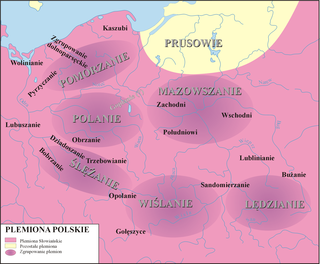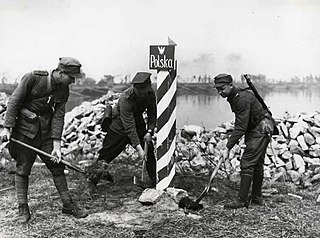
Silesia is a historical region of Central Europe that lies mostly within Poland, with small parts in the Czech Republic and Germany. Its area is approximately 40,000 km2 (15,400 sq mi), and the population is estimated at 8,000,000. Silesia is split into two main subregions, Lower Silesia in the west and Upper Silesia in the east. Silesia has a diverse culture, including architecture, costumes, cuisine, traditions, and the Silesian language. The largest city of the region is Wrocław.

Opole is a city located in southern Poland on the Oder River and the historical capital of Upper Silesia. With a population of approximately 127,387 as of the 2021 census, it is the capital of Opole Voivodeship (province) and the seat of Opole County. Its built-up was home to 146,522 inhabitants. It is the largest city in its province.

Upper Silesia is the southeastern part of the historical and geographical region of Silesia, located today mostly in Poland, with small parts in the Czech Republic. The area is predominantly known for its heavy industry.

Brzeg is a town in southwestern Poland with 34,778 inhabitants and the capital of Brzeg County. It is situated in Silesia in the Opole Voivodeship on the left bank of the Oder river.

Prudnik is a town in southern Poland, located in the southern part of Opole Voivodeship near the border with the Czech Republic. It is the administrative seat of Prudnik County and Gmina Prudnik. Its population numbers 21,368 inhabitants (2016). Since 2015, Prudnik is a member of the Cittaslow International.

Silesians is both an ethnic as well as a geographical term for the inhabitants of Silesia, a historical region in Central Europe divided by the current national boundaries of Poland, Germany, and Czechia. Historically, the region of Silesia has been inhabited by Polish, Czechs, and by Germans. Therefore, the term Silesian can refer to anyone of these ethnic groups. However, in 1945, great demographic changes occurred in the region as a result of the Potsdam Agreement leaving most of the region ethnically Polish and/or Slavic Upper Silesian. The Silesian language is one of the regional languages used in Poland alongside Polish as well as Kashubian and is structured with in a SVO format, however the grammar is quite often different to that of the other Lechitic languages. The names of Silesia in different languages most likely share their etymology—Polish: ; German: Schlesienpronounced[ˈʃleːzi̯ən] ; Czech: Slezsko ; Lower Silesian: Schläsing; Silesian: Ślōnsk ; Lower Sorbian: Šlazyńska ; Upper Sorbian: Šleska ; Latin, Spanish and English: Silesia; French: Silésie; Dutch: Silezië; Italian: Slesia; Slovak: Sliezsko; Kashubian: Sląsk. The names all relate to the name of a river and mountain in mid-southern Silesia, which served as a place of cult for pagans before Christianization.

The Province of Upper Silesia was a province of the Free State of Prussia from 1919 to 1945. It comprised much of the region of Upper Silesia and was eventually divided into two government regions called Kattowitz (1939–1945), and Oppeln (1819–1945). The provincial capital was Oppeln (1919–1938) and Kattowitz (1941–1945), while other major towns included Beuthen, Gleiwitz, Hindenburg O.S., Neiße, Ratibor and Auschwitz, added in 1941. Between 1938 and 1941 it was reunited with Lower Silesia as the Province of Silesia.

In the second half of the 2nd millennium B.C., Silesia belonged to the Lusatian culture. About 500 BC Scyths arrived, and later Celts in the South and Southwest. During the 1st century BC Silingi and other Germanic people settled in Silesia. For this period we have written reports of antique authors who included the area. Slavs arrived in this territory around the 6th century. The first known states in Silesia were those of Greater Moravia and Bohemia. In the 10th century, Mieszko I incorporated Silesia into Civitas Schinesghe, a Polish state. It remained part of Poland until the Fragmentation of Poland. Afterwards it was divided between Piast dukes, descendants of Władysław II the Exile, High Duke of Poland.

"Polish tribes" is a term used sometimes to describe the tribes of West Slavic Lechites that lived from around the mid-6th century in the territories that became Polish with the creation of the Polish state by the Piast dynasty. The territory on which they lived became a part of the first Polish state created by duke Mieszko I and expanded at the end of the 10th century, enlarged further by conquests of king Bolesław I at the beginning of the 11th century.

The Vistulans, or Vistulanians, were an early medieval Lechitic tribe inhabiting the western part of modern Lesser Poland.

Grodków is a town in Brzeg County, Opole Voivodeship in Poland, the administrative seat of Gmina Grodków. It is located in the Silesian Lowlands of the Oder basin, in the historic Upper Silesia region, about 20 km (12 mi) south of Brzeg. In the north, it has access to the A4 autostrada. The town has 8,595 inhabitants (2019).

Lower Silesia is a historical and geographical region mostly located in Poland with small portions in the Czech Republic and Germany. It is the western part of the region of Silesia. Its largest city is Wrocław.

The Silesians were a tribe of West Slavs, specifically of the Lechitic/Polish group, inhabiting territories of Lower Silesia, near Ślęża mountain and Ślęza river, on both banks of the Oder, up to the area of modern city of Wrocław. They were the first permanent inhabitants of the site of Wrocław where they build a fort on Ostrów Tumski in the 9th century or earlier, which at the time was an island on the Oder.
The most important phenomenon that took place within the lands of Poland in the Early Middle Ages, as well as other parts of Central Europe was the arrival and permanent settlement of the West Slavic or Lechitic peoples. The Slavic migrations to the area of contemporary Poland started in the second half of the 5th century AD, about a half century after these territories were vacated by Germanic tribes fleeing from the Huns. The first waves of the incoming Slavs settled the vicinity of the upper Vistula River and elsewhere in the lands of present southeastern Poland and southern Masovia. Coming from the east, from the upper and middle regions of the Dnieper River, the immigrants would have had come primarily from the western branch of the early Slavs known as Sclaveni, and since their arrival are classified as West Slavs and Lechites, who are the closest ancestors of Poles.[a]
The Silesian tribes is a term used to refer to tribes, or groups of West Slavs that lived in the territories of Silesia in the Early Middle Ages. The territory they lived on became part of Great Moravia in 875 and later, in 990, the first Polish state created by duke Mieszko I and then expanded by king Boleslaw I at the beginning of the 11th century. They are usually treated as part of the Polish tribes and sometimes as part of the Germanic tribes. Two tribes among them are sometimes considered as Czech (Moravian) tribes.

Silesian Przesieka, literally Silesian Cutting was a densely forested, uninhabited and unpassable strip of land in the middle of Silesia, spreading from Golden Mountains in the south, along the Nysa Kłodzka to the Odra, and then along the Stobrawa, reaching the towns of Namysłów and Byczyna in northern Silesia. Originally, the Silesian Cutting was a boundary, separating territories of two Western Slavic tribes, the Slezanie and the Opolanie. In the 12th century, along the Cutting a border of Lower Silesia and Upper Silesia was established.

The Commission for the Determination of Place Names was a commission of the Polish Department of Public Administration, founded in January 1946. Its mission was the establishment of toponyms for places, villages, towns and cities in the former eastern territories of Germany.

The Golensizi were a tribe of West Slavs, specifically of the Lechitic tribes, living in the Early Middle Ages and inhabiting southern territories of what was later known as Upper Silesia, on the upper Oder River.
The Duchy of Prudnik was one of the numerous duchies of Silesia ruled by the Silesian branch of the royal Polish Piast dynasty. Its capital was Prudnik in Upper Silesia.

The coat of arms of Silesia and Lower Silesia displays a black eagle with silver crescent with a cross in the middle on its chest—the emblem of Silesian Duke Henry the Bearded —on a golden background. It has been assumed in the tradition that the coat of arms and colors of Lower Silesia are simultaneously used as symbols of Silesia as a whole.
















